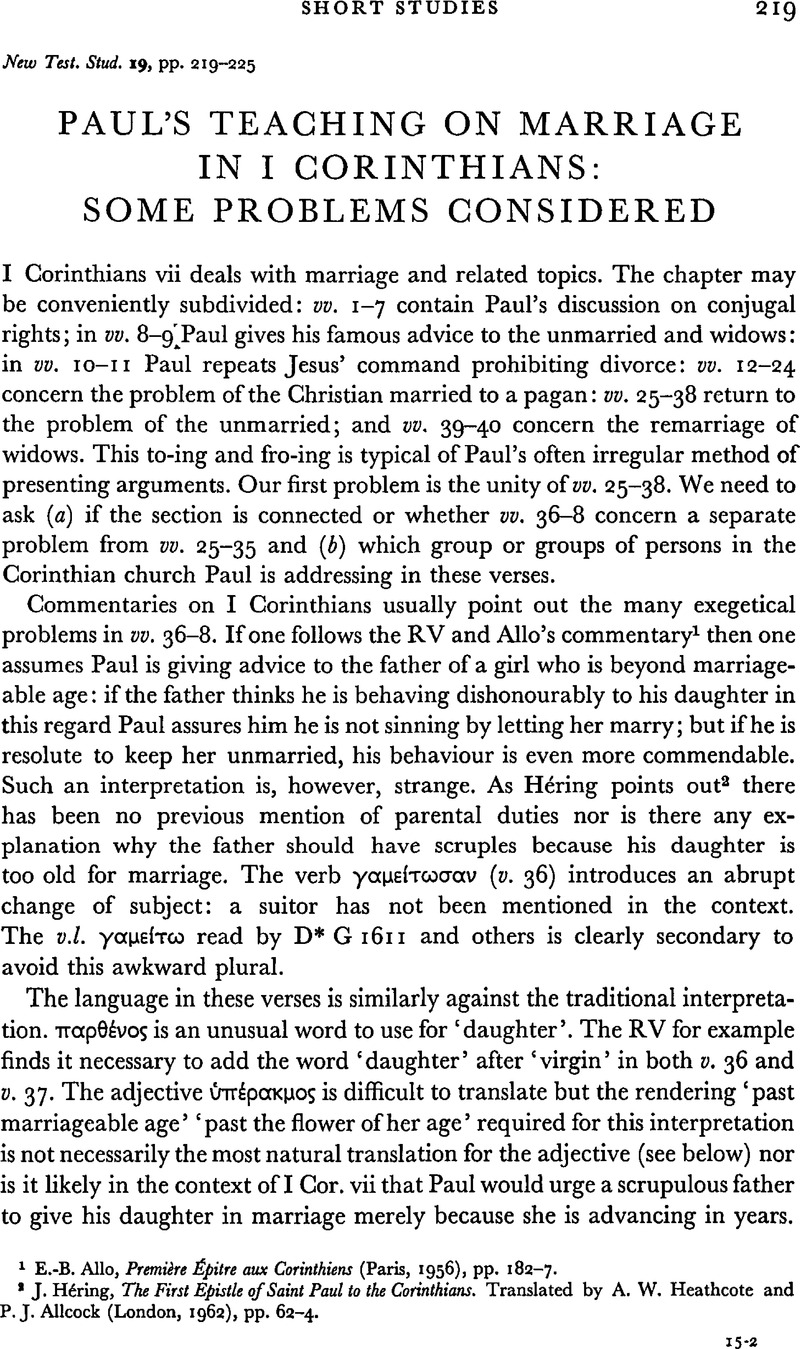Article contents
Paul's Teaching on Marriage in I Corinthians: Some Problems Considered
Published online by Cambridge University Press: 05 February 2009
Abstract

- Type
- Short Studies
- Information
- Copyright
- Copyright © Cambridge University Press 1973
References
page 219 note 1 Allo, E.-B., Première Épitre aux Corinthiens (Paris, 1956), pp. 182–7.Google Scholar
page 219 note 2 Héring, J., The First Epistle of Saint Paul to the Corinthians. Translated by Heathcote, A. W. and Allcock, P. J. (London, 1962), pp. 62–4.Google Scholar
page 220 note 1 Lietzmann, H., An die Korinther I–II (Handbuch zum Neuen Testament 9) (Tübingen, 4th edition 1949), pp. 35–6.Google Scholar
page 220 note 2 See also Elliott, J. K., The Greek Text of the Epistles to Timothy and Titus (Studies and Documents 36) (Utah, 1968), p. 79.Google Scholar
page 222 note 1 Notice how many difficulties Barrett finds by taking v. 29 to refer to marriage. In Barrett, C. K., A Commentary on the First Epistle to the Corinthians (Black's New Testament Commentaries) (London, 1968), pp. 176–7.Google Scholar
page 222 note 2 Op. cit. p. 175.
page 222 note 3 Robertson, A. and Plummer, A., A Critical and Exegetical Commentary on the First Epistle of St Paul to the Corinthians (International Critical Commentary) (Edinburgh, 1911), p. 153.Google Scholar
page 223 note 1 For example by Barrett, C. K. (op. cit. p. 174) and by Hurd, J. C. Jr, The Origin of I Corinthians (London, 1965), pp. 178–9 and see pp. 290–1.Google Scholar
page 223 note 2 Pace Ford, J. M. ‘Levirate Marriage in St Paul (I Cor. vii),’ N.T.S. x (1963–1964), 361–5Google Scholar. On the question of virgines subintroductae see Chadwick, H., ‘All Things to All Men,’ N.T.S. I (1955), 267 ffGoogle Scholar. and Black, M., The Scrolls and Christian Origins (London, 1961), pp. 84 ff.Google Scholar
page 223 note 3 Op. cit. pp. 176–80.
page 224 note 1 If it can be maintained that in II Cor. vi. 14-vii. 1 Paul is speaking not against immorality as such but against mixed marriages (as is possibly indicated by vi. 14 and by the addition in vi. 18 of καλ θυγατέρας to the quotation of II Sam. vii. 14) then it will be seen that Paul's attitude has hardened. In both letters he speaks against mixed marriages in the future, but in II Cor. vi. 14-vii. 1 he appears to encourage the dissolution of existing mixed marriages.
page 224 note 2 Op. cit. p. 166.
page 224 note 3 Op. cit. p. 140 (footnote).
page 225 note 1 So ICC (op. cit. p. 144 and Héring (op. cit. p. 53).
page 225 note 2 So Barrett (op. cit. p. 167).
- 1
- Cited by




